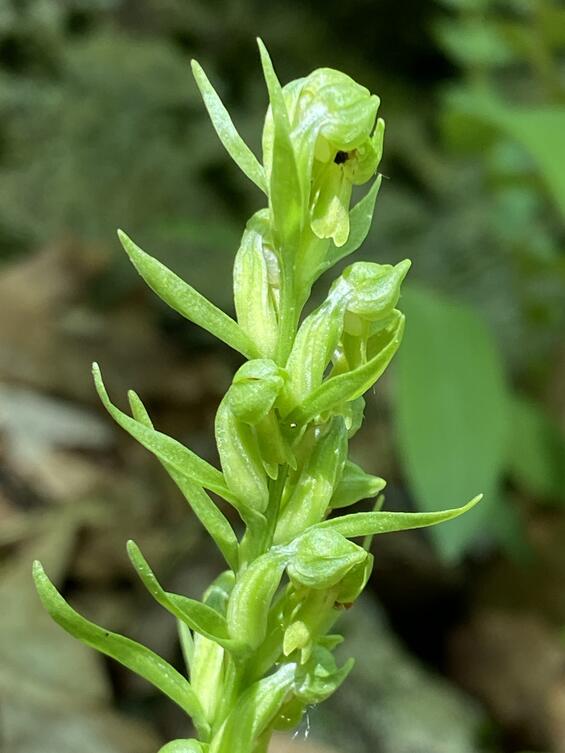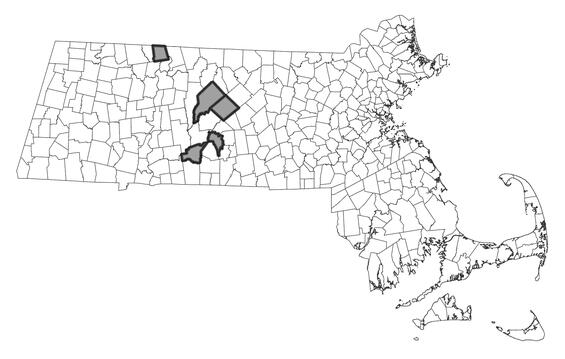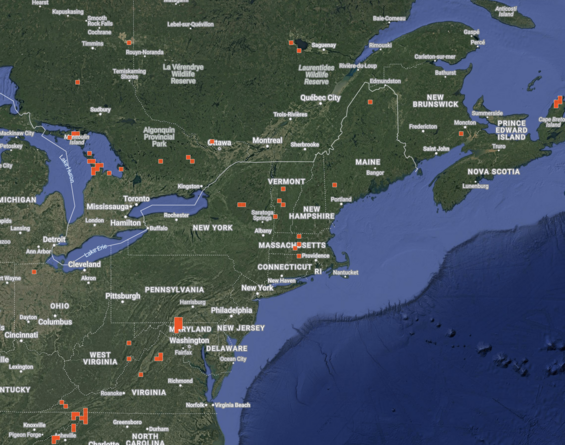- Scientific name: Dactylorhiza viridis (Linnaeus) R.M. Bateman, Pridgeon, & M.W. Chase
- Synonym: Coeloglossum viride (L.) Hartm.
- Species of Greatest Conservation Need (MA State Wildlife Action Plan)
- Endangered (MA Endangered Species Act)
Description

Frog orchid. Photo by Doug McGrady.
Frog orchids are green to yellow-green plants up to 55cm (21.7 in) in height with usually 3 to 6 leaves. The blades gradually reduced in size upwards on the stem. The leaves are long and narrow with the shape varying between different plants and between upper and lower leaves. Leaves may be obovate, oblong, lanceolate, elliptic or some combination of those shapes, up to 13 cm (5.1 in) in length and up to 6 cm (2.4 in) wide. The flowering structure is a long straight spike of flowers up to 24 cm (9.4 in) in height and can take up to almost half of the total stem height. The flowers are small and greenish yellow, with the most distinctive feature a long, narrow lower lip up to 11 mm (0.43 in) in length and up to 3.5 mm (0.14 in) wide, with a notch in the center of the bottom (distal) part of the lip. As one of the common names suggested, each flower is subtended by a long green, almost leafy bract up to 5.5 cm (2.2 in) long, getting shorter as one moves upward toward the tip of the plant. The largest bracts are to up 5 times as long as the flower itself (Smith 2012).
Life cycle and behavior
Herbaceous perennial.
Population status
MassWildlife’s Natural Heritage & Endangered Species Program (NHESP) database has 10 records from 8 towns in 3 counties: Franklin, Hampden, and Worcester. Six of these records have been observed within the last 25 years. Each population is very small, between one and six plants. In a 10-year repeating survey with five botanists, across all 26 towns in Franklin County, Dactylorhiza viridis showed a decline from prior occurrences in 13 towns, down to only a single town. This was the second highest absolute decline next to adder’s tongue fern (Ophioglossum pusillum).

Distribution in Massachusetts
1999-2024
Based on records in the Natural Heritage Database
Distribution and abundance
In New England, NatureServe Explorer ranks frog orchid in Vermont as S2 imperiled, New Hampshire as vulnerable, Maine and Rhode Island are not ranked and Connecticut is critically imperiled (S1). New York’s ranking is S1S2. Eleven states further west and south are all ranked S1, critically imperiled, with Virginia ranked apparently secure. Further north, Ontario and Quebec are also apparently secure. iNaturalist tells a somewhat different story for New England and New York. Orchids attract a great deal of attention on iNaturalist as elsewhere. There are 1399 research grade observations in North America, yet New Hampshire has none, Maine has two, Vermont 4, New York and Massachusetts each have 3, and Connecticut just one. These numbers suggest that numbers in these states are in sharp decline. Comparing numbers for a similarly ranked orchid, Arethusa bulbosa (dragon’s mouth), there are 116 research grade observations in those same states, not including Maine (iNaturalist.org 2025).

iNaturalist research grade observations of Dactylorhiza viridis within the northeastern North America region as of 24 March 2025.
Habitat
The species occurs in rich mesic woods, generally on rocky slopes with sugar maple and white ash the dominant trees. Understory associates in one location include Tiarella cordifolia, Aquilegia canadensis, Epipactis helleborine, Trillium erectum, Polystichum acrostichoides, and Cystopteris fragilis.
Healthy habitats are vital for supporting native wildlife and plants. Explore habitats and learn about conservation and restoration in Massachusetts.
Threats
This species occurs far to the north in North America and becomes rare south of a line from Chicago to Providence, RI. This being a species of more northerly distribution, climate warming is a potential threat. The past 130 years have seen a warming of 1.4 °C, (2.5 ° F) in the Northeast United States (Staudinger et al. 2024). Northern species can be expected to move much further north in an attempt to occupy a habitat within their evolved climate envelope. Temperature and seasonality changes also disrupt synchronization of pollinators to plant flowering.
The dust-like seeds of orchids rely on mycorrhizae for its seed germination, protocorm formation and growth into a seedling. Therefore, it is quite likely that changes in species composition and abundance of mycorrhizae will strongly affect orchids over time. Causes of orchid decline could include, but are not limited to, deer herbivory (Knapp and Wiegand 2014), earthworms (McCormick et at. 2013), lack of disturbance (Sheviak 1990), nitrogen deposition (Figura et al. 2020, Whalen et al. 2018), invasive, non-native species such as garlic mustard (Anthony et al. 2017), and canopy closure (Brumback et al. 2011, Whigham et al. 2021), all of which affect orchids in Massachusetts (Frost 2023). Other specific threats include changes in climate, which might cause a disassociation with its pollinators.
Conservation
Survey and monitoring
This is a green flowering orchid that might typically grow in a lush understory making discovery of populations a bit more challenging that other species. Given the apparent sharp decline in frog orchid, much more de novo surveying is needed as well as more thorough resurvey work on known populations. All populations need increased monitoring.
Management needs
Management needs include removal and control of invasive species, as well as avoidance of timber harvest in the area.
Research needs
Research needs include evaluation of light management practices to answer the question as to whether this species might response to increases in light reaching the forest floor. Many other research needs are those that would specifically address the threats listed above.
References
Anthony, M. A., S. D. Frey, and K. A. Stinson. 2017. Fungal community homogenization, shift in dominant trophic guild, and appearance of novel taxa with biotic invasion. Ecosphere 8: n/a-n/a.
Bertin, R. I., M. G. Hickler, K. B. Searcy, G. Motzkin, and P. P. Grima. 2020. Vascular Flora of Franklin County, Massachusetts. New England Botanical Club. 390pp.
Brumback, W. E., S. Cairns, M. B. Sperduto, and C. W. Fyler. 2011. Response of an Isotria medeoloides Population to Canopy Thinning. Northeastern Naturalist 18: 185–196.
Consortium of Northeastern Herbaria. 2025. Herbarium records. https://portal.neherbaria.org/portal/collections/list.php. Accessed 3/13/2025.
Figura, T., M. Weiser, and J. Ponert. 2020. Orchid seed sensitivity to nitrate reflects habitat preferences and soil nitrate content. Plant Biology 22: 21–29.
Frost, Karro. 2023. Species listing proposal for Dactylorhiza viridis. Massachusetts Natural Heritage & Endangered Species. Massachusetts Division of Fisheries and Wildlife, Westborough, MA.
iNaturalist 2025. Available from https://www.inaturalist.org. Accessed 24 March 2025
Knapp WM, Wiegand R (2014) orchid (orchidaceae) decline in the Catoctin Mountains, Frederick County, Maryland as documented by a long-term dataset. Biodivers Conserv 23:1965–1976. https://doi.org/10.1007/s10531-014-0698-2
McCormick, M. K., K. L. Parker, K. Szlavecz, and D. F. Whigham. 2013. Native and exotic earthworms affect orchid seed loss. AoB PLANTS 5: plt018.
NatureServe. 2025. NatureServe Network Biodiversity Location Data accessed through NatureServe Explorer [web application]. NatureServe, Arlington, Virginia. Available https://explorer.natureserve.org/. Accessed: 3/19/2025
Sheviak, C. J. 1990. Biological considerations in the management of temperate terrestrial orchid habitats. New York State Museum Bulletin 471: 194–196.
Smith, Welby R. 2012. Native orchids of Minnesota [revision of orchids of Minnesota by Welby R. Smith]. University of Minnesota Press, Minneapolis, London. xxxi + 254 pp. Illustrated by Vera Ming Wong and Bobby Angell. ISBN 978-0-8166-7823-5. Paperback.
Staudinger, M.D., A.V. Karmalkar, K. Terwilliger, K. Burgio, A. Lubeck, H. Higgins, T. Rice, T.L. Morelli, A. D'Amato. 2024. A regional synthesis of climate data to inform the 2025 State Wildlife Action Plans in the Northeast U.S. DOI Northeast Climate Adaptation Science Center Cooperator Report. 406 p. https://doi.org/10.21429/t352-9q86
Whalen, E. D., R. G. Smith, A. S. Grandy, and S. D. Frey. 2018. Manganese limitation as a mechanism for reduced decomposition in soils under atmospheric nitrogen deposition. Soil Biology and Biochemistry 127: 252–263.
Whigham, D., M. McCormick, H. Brooks, B. Josey, R. Floyd, and J. Applegate. 2021. Isotria medeoloides, a North American Threatened orchid: Fungal Abundance May Be as Important as Light in Species Management. Plants 10: 1924.
Contact
| Date published: | April 10, 2025 |
|---|